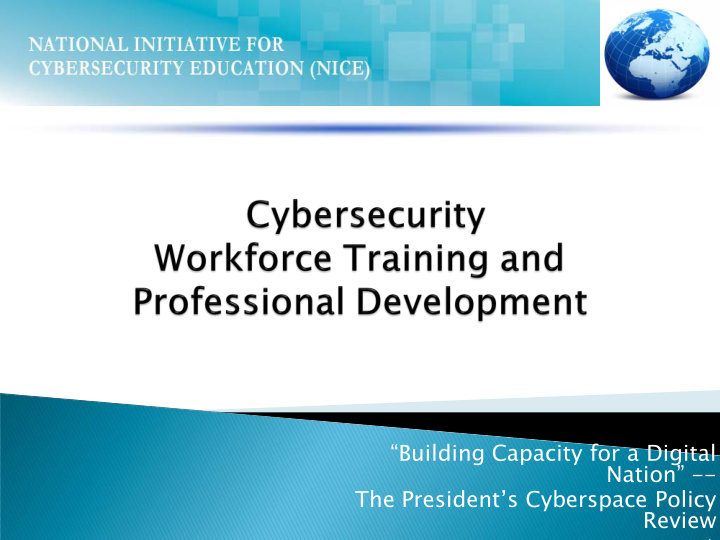



“Building Capacity for a Digital Nation” -- The President’s Cyberspace Policy Review 1
In collaboration with the private sector and state, local and tribal partners, Track 4 will establish, provide or otherwise set standards and strategies for nation onal cybersecurity training and professional development. 2
Track Co-Leads Jane Homeyer, PhD Peggy Maxson John Mills ODNI/CHCO DHS/NCSD DoD/CIO FA2: IT Infrastructure, Operations, FA1: General IT Use Maintenance, and Information Assurance Leads Leads Roy Burgess, DHS George Bieber, DoD Chris Kelsall, DoN Roy Burgess, , DHS FA4: Specialized Cybersecurity FA3: Domestic Law Enforcement Operations and Counterintelligence Leads Matt Parsons, DC3 Lead Ron Sinkler, NCIX CAPT Jill Newton, NSA Jason Chipman, DOJ Jim Florio, USSS 3
Task 1 – Population Review Task 2 – Training Catalog Task 3 – Workforce Baseline Study Task 4 – Workforce & Training Analysis (Identification of gaps) Task 5 – Professional Development Roadmaps Task 6 - Communication 4
NIST SP 800-16, Rev. 1 (NIST) Development of a Department of Defense Cybersecurity Workforce Framework and Preliminary Training Gap Analysis , July 2010 (DOD) Federal Cybersecurity Workforce Transformation Working Group Report on Cybersecurity Competencies , July 2010 (DOD, DHS) IT Security Workforce Matrix Project (FED CIO IT Workforce Committee) Competency Model for Cybersecurity , 16 Feb 2011 (OPM – NICE Track 3) Comprehensive National Cyber Initiative #8 Expand Cyber Education Activities (Leads: DHS, NSA) ISS LOB Tier 1 Awareness Training Initiative (Lead: DHS) ISS LOB Tier 2 Role-Based Training Initiative (Lead: DHS) Essential Body of Knowledge (Lead: DHS) CNSS Education Training and Awareness Working Group & Training Standards (Lead: CNSS) 5
NICE effort serves as the focal point for existing and future cybersecurity workforce development initiatives. Compilation of all previous Federal efforts; collaborating with SLT, academia and private sector. A single touch point for the nation that is recognized as the “go to” point for cybersecurity education and training. NICE, partnering with all of those who strive to improve the capabilities and effectiveness of cybersecurity professionals, can begin to build to the future. 6
Federal – guidelines and standards State, Local, Tribal – encourage participation in building and common acceptance Academia - collaborate and ensure best practices, encourage common adoption or crosswalk Industry – collaborate and ensure best practices, encourage common adoption or crosswalk 7
8
NICE effort serves as the focal point for existing and future cybersecurity workforce development initiatives. Compilation of all previous Federal efforts; collaborating with SLT, academia and private sector. A single touch point for the nation that is recognized as the “go to” point for cybersecurity education and training. NICE, partnering with all of those who strive to improve the capabilities and effectiveness of cybersecurity professionals, can begin to build to the future. 9
Recommend
More recommend